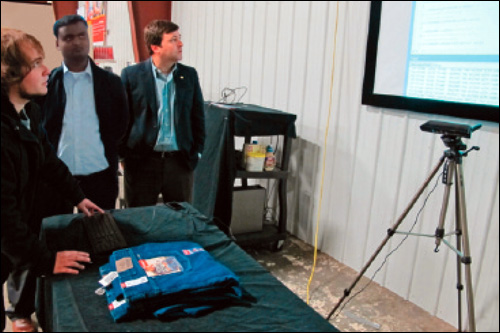Increasingly, apparel retailers are adopting radio frequency identification technology, which provides visibility into the location of movable assets, to monitor items moving from the back room to the sales floor and on store shelves. Studies show RFID improves inventory accuracy and is less labor-intensive than tracking items manually with bar codes. Yet, some retailers are reluctant to use RFID because it is automatic. They often ask, “If I read items on a shelf, how do I know I got everything?” With bar codes, retailers feel, “If I scan it, I see it.”
The University of Arkansas’ RFID Research Center may have the solution: combining RFID with vision technology. In a demonstration set up in the center’s lab, researchers used Kinect—the Webcam-like device that allows players to interact with Xbox 360 games—to capture images of items, while reading tags with an ultrahigh-frequency reader under the table. The system could enable retailers to see if items are actually where RFID says they are. Having two sources of data-capture information will give retailers and other end users confidence that RFID systems are accurate, says Justin Patton, the center’s director.

“Harry Scott, a student working in the lab, saw us identifying items with RFID and said he could do that with a Kinect device,” Patton says. To demonstrate how it would work, Scott put a soda can and several other items on a table. The Kinect camera scanned the items and matched their characteristics to those of items stored in a database, to determine what the items were (currently, it works with roughly 10 items).
“The demo allows the user to define an area of interest, and then identify items in it by analyzing their size, shape and color,” Patton says. The researchers plan to add optical character recognition for even greater accuracy. “You can now get a camera that can deliver pretty high-quality video and infrared range and create a point cloud of a 3-D environment for $100 or so,” Scott adds.
The 3-D video system can’t determine exactly how many jeans are in a stack on a shelf, but it could be set up to learn that, say, six pairs of a certain type take up a specific amount of volumetric space. If the RFID system reads six tags and the camera records a corresponding volume, the retailer could be sure that six pairs of jeans are on the shelf.
3-D video cameras also could be used to tell retailers whether a shoplifter has removed an item and left its RFID tag on the shelf. To demo this, researchers placed three tagged items and two unattached tags on a table. An RFID reader identified all five tags, but the Kinect camera saw only three items. Software could alert retail staff when such a discrepancy is detected.
The RFID Research Center team plans to mount a Kinect camera or similar device on an RFID handheld to see if it can capture visual images and RFID data while taking inventory of a store.
“With vision technologies alone, I could tell there are items on the shelf and where they are, but I can’t see the items behind those in the front row,” Patton says. “With RFID, I can read tags on the items behind those in the front, most of the time, but I’m not sure where they are. So these are very complementary technologies.”

